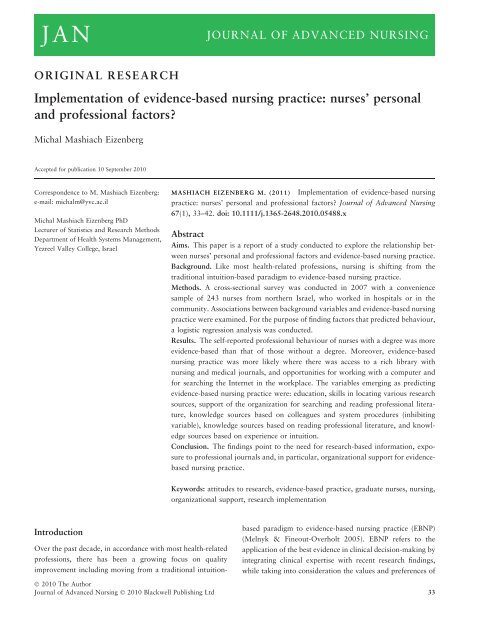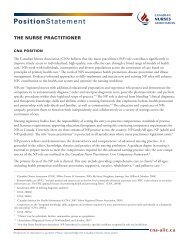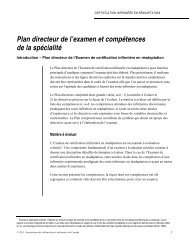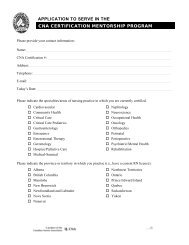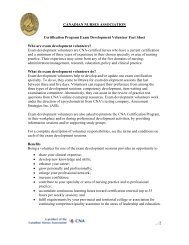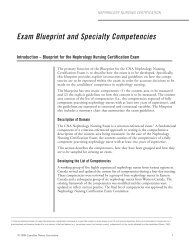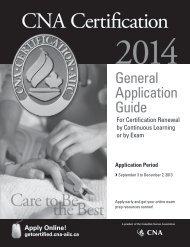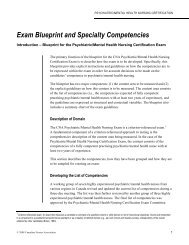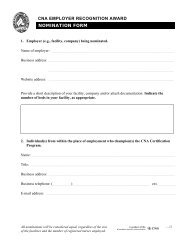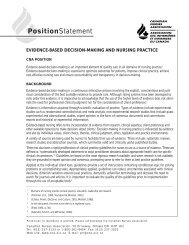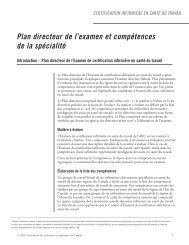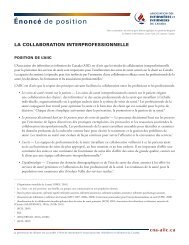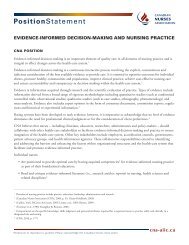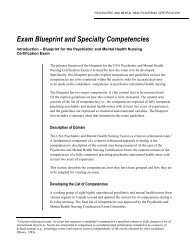nurses personal and professional factors? - NurseONE
nurses personal and professional factors? - NurseONE
nurses personal and professional factors? - NurseONE
You also want an ePaper? Increase the reach of your titles
YUMPU automatically turns print PDFs into web optimized ePapers that Google loves.
JAN<br />
JOURNAL OF ADVANCED NURSING<br />
ORIGINAL RESEARCH<br />
Implementation of evidence-based nursing practice: <strong>nurses</strong>’ <strong>personal</strong><br />
<strong>and</strong> <strong>professional</strong> <strong>factors</strong>?<br />
Michal Mashiach Eizenberg<br />
Accepted for publication 10 September 2010<br />
Correspondence to M. Mashiach Eizenberg:<br />
e-mail: michalm@yvc.ac.il<br />
Michal Mashiach Eizenberg PhD<br />
Lecturer of Statistics <strong>and</strong> Research Methods<br />
Department of Health Systems Management,<br />
Yezreel Valley College, Israel<br />
MASHIACH EIZENBERG M. (2011)<br />
Implementation of evidence-based nursing<br />
practice: <strong>nurses</strong>’ <strong>personal</strong> <strong>and</strong> <strong>professional</strong> <strong>factors</strong>? Journal of Advanced Nursing<br />
67(1), 33–42. doi: 10.1111/j.1365-2648.2010.05488.x<br />
Abstract<br />
Aims. This paper is a report of a study conducted to explore the relationship between<br />
<strong>nurses</strong>’ <strong>personal</strong> <strong>and</strong> <strong>professional</strong> <strong>factors</strong> <strong>and</strong> evidence-based nursing practice.<br />
Background. Like most health-related professions, nursing is shifting from the<br />
traditional intuition-based paradigm to evidence-based nursing practice.<br />
Methods. A cross-sectional survey was conducted in 2007 with a convenience<br />
sample of 243 <strong>nurses</strong> from northern Israel, who worked in hospitals or in the<br />
community. Associations between background variables <strong>and</strong> evidence-based nursing<br />
practice were examined. For the purpose of finding <strong>factors</strong> that predicted behaviour,<br />
a logistic regression analysis was conducted.<br />
Results. The self-reported <strong>professional</strong> behaviour of <strong>nurses</strong> with a degree was more<br />
evidence-based than that of those without a degree. Moreover, evidence-based<br />
nursing practice was more likely where there was access to a rich library with<br />
nursing <strong>and</strong> medical journals, <strong>and</strong> opportunities for working with a computer <strong>and</strong><br />
for searching the Internet in the workplace. The variables emerging as predicting<br />
evidence-based nursing practice were: education, skills in locating various research<br />
sources, support of the organization for searching <strong>and</strong> reading <strong>professional</strong> literature,<br />
knowledge sources based on colleagues <strong>and</strong> system procedures (inhibiting<br />
variable), knowledge sources based on reading <strong>professional</strong> literature, <strong>and</strong> knowledge<br />
sources based on experience or intuition.<br />
Conclusion. The findings point to the need for research-based information, exposure<br />
to <strong>professional</strong> journals <strong>and</strong>, in particular, organizational support for evidencebased<br />
nursing practice.<br />
Keywords: attitudes to research, evidence-based practice, graduate <strong>nurses</strong>, nursing,<br />
organizational support, research implementation<br />
Introduction<br />
Over the past decade, in accordance with most health-related<br />
professions, there has been a growing focus on quality<br />
improvement including moving from a traditional intuitionbased<br />
paradigm to evidence-based nursing practice (EBNP)<br />
(Melnyk & Fineout-Overholt 2005). EBNP refers to the<br />
application of the best evidence in clinical decision-making by<br />
integrating clinical expertise with recent research findings,<br />
while taking into consideration the values <strong>and</strong> preferences of<br />
Ó 2010 The Author<br />
Journal of Advanced Nursing Ó 2010 Blackwell Publishing Ltd 33
M. Mashiach Eizenberg<br />
patients (French 1999, Coopey et al. 2006). EBNP is derived<br />
from the general movement toward evidence-based medicine<br />
in general healthcare (Sackett et al. 1996) <strong>and</strong> has had a<br />
profound impact on several disciplines, such as medicine<br />
(Soltani & Moayyeri 2005) <strong>and</strong> mental health (Drake et al.<br />
2005), influencing practices (Straus et al. 2005) <strong>and</strong> behavioural<br />
healthcare (Titler et al. 2009).<br />
Background<br />
The EBNP process consists of five stages: (1) formulating a<br />
question that will yield the most suitable answer; (2)<br />
gathering the most relevant information by systematic search<br />
of the literature or clinical guidelines; (3) performing critical<br />
evaluation of the evidence <strong>and</strong> its validity, relevance <strong>and</strong><br />
feasibility; (4) integrating research evidence with clinical<br />
experience, patients’ values <strong>and</strong> preferences <strong>and</strong> (5) assessing<br />
treatment outcomes (Melnyk & Fineout-Overholt 2005).<br />
Implementing EBNP is potentially beneficial for patients<br />
<strong>and</strong> healthcare systems, <strong>and</strong> for <strong>nurses</strong>. It enhances patients’<br />
access to <strong>and</strong> information about effective treatment<br />
(Melnyk & Fineout-Overholt 2005). EBNP can improve<br />
the healthcare system by facilitating consistent decisionmaking<br />
<strong>and</strong> advancing cost-effectiveness (Le May 1999).<br />
Finally, EBNP can help <strong>nurses</strong> by facilitating informed <strong>and</strong><br />
evidence-based clinical decision-making, helping them to<br />
keep updated with technologies, <strong>and</strong> enabling greater<br />
efficiency (Youngblut & Brooten 2001). These new competencies,<br />
in turn, can raise <strong>nurses</strong>’ status in multi-<strong>professional</strong><br />
teams (Tod et al. 2004) <strong>and</strong> the profession in general.<br />
Nurses who are involved in EBNP have been found to<br />
express a sense of <strong>professional</strong>ism <strong>and</strong> growth, which<br />
contributes to their <strong>professional</strong> identity (Hutchinson &<br />
Johnston 2004, Newhouse 2006).<br />
Despite the advantages of EBNP, research reveals that<br />
<strong>nurses</strong> prefer to be informed by colleagues, rather than using<br />
the Internet or nursing databases, <strong>and</strong> that most rely only on<br />
what they learned during their nursing education <strong>and</strong> from<br />
experience (Estabrooks 1999, Egerod & Hansen 2005,<br />
Pravikoff et al. 2005). Few <strong>nurses</strong> appear to use library<br />
services (Pravikoff et al. 2005), <strong>and</strong> even when knowledge is<br />
acquired through journal reading, it is rarely systematically<br />
applied (Retsas 2000, Banning 2005). However, a recent<br />
study revealed that the sources of <strong>nurses</strong>’ <strong>professional</strong><br />
information are literature searches, research, medical journals<br />
<strong>and</strong> reports of controlled experiments (Banning 2005).<br />
The consensus on the importance <strong>and</strong> benefit of EBNP,<br />
along with evidence that actual implementation of EBNP is<br />
rare, has generated efforts to develop strategies to facilitate<br />
dissemination of EBNP at the organizational <strong>and</strong> individual<br />
levels. Kitson et al. (1998) developed a model to identify<br />
variables influencing the implementation of EBNP <strong>and</strong><br />
found the organization to be the most important factor.<br />
Funk et al. (1995) proposed an integrative approach emphasizing<br />
the importance of research synthesis, access <strong>and</strong><br />
dialogue, <strong>and</strong> the structure <strong>and</strong> support of practice institutions.<br />
Similarly, Thompson et al. (2007) conducted a<br />
systematic literature review about activities performed to<br />
enhance the use of research findings in nursing practice <strong>and</strong><br />
found organizational training to be the most important<br />
factor.<br />
A number of large institutes in the United States of America<br />
(USA) have declared that EBNP is the formal policy of their<br />
organization, <strong>and</strong> their management has made special efforts<br />
to implement EBNP by engaging a nursing research coordinator,<br />
operating a nursing research committee <strong>and</strong> offering a<br />
course in EBNP to head <strong>nurses</strong>. These efforts were effective,<br />
as these institutes were found to display greater use of<br />
research results in practice (Estabrooks 1999, Egerod &<br />
Hansen 2005, Pravikoff et al. 2005). A notable example is<br />
the Iowa Model of Evidence-Based Practice to Promote<br />
Quality Care (Titler 2007), which approaches EBP from an<br />
organization perspective <strong>and</strong> uses a variety of evidence, with<br />
a focus on evaluating <strong>and</strong> implementing EBP to bring about<br />
improvements in care.<br />
Parahoo (1998) examined whether attitudes towards<br />
research had an impact on implementing study findings.<br />
He found that despite <strong>nurses</strong>’ positive attitudes toward<br />
research, only few implemented study findings in the course<br />
of their work. Specifically, no relationship was found<br />
between attitudes <strong>and</strong> implementation. Studies of <strong>nurses</strong>’<br />
attitudes towards research have revealed mixed results. On<br />
the one h<strong>and</strong>, several studies have demonstrated <strong>nurses</strong>’<br />
positive attitudes towards research <strong>and</strong> agreement that<br />
research <strong>and</strong> EBNP are relevant for their daily practice<br />
(Nagy et al. 2001, Sanzero-Eller et al. 2003, Wallin et al.<br />
2003, Milner et al. 2006). Others have claimed that evidence<br />
in nursing exists, <strong>and</strong> that EBNP indeed advances nursing<br />
practice (Parahoo 1998, Veeramah 2004, Egerod & Hansen<br />
2005). In other studies, however, researchers have reported<br />
that <strong>nurses</strong> held negative attitudes towards research, <strong>and</strong> few<br />
maintained that the research in its current form is applicable<br />
to their work (Nagy et al. 2001). Furthermore, <strong>nurses</strong>’<br />
attitudes towards research were found to be less positive<br />
than those of other healthcare <strong>professional</strong>s (Sanzero-Eller<br />
et al. 2003).<br />
In a systematic literature review, a positive correlation was<br />
found between practice according to research findings <strong>and</strong><br />
attitudes towards research, <strong>and</strong> between educational level<br />
<strong>and</strong> reading <strong>professional</strong> journals. Moreover, these <strong>nurses</strong><br />
Ó 2010 The Author<br />
34 Journal of Advanced Nursing Ó 2010 Blackwell Publishing Ltd
JAN: ORIGINAL RESEARCH<br />
Implementation of evidence-based nursing practice<br />
reported being engaged in reading <strong>professional</strong> journals more<br />
frequently than other <strong>nurses</strong> (Milner et al. 2006).<br />
In addition to organizational <strong>factors</strong> <strong>and</strong> <strong>personal</strong> attitudes,<br />
research has focused on <strong>nurses</strong>’ knowledge <strong>and</strong><br />
experience with EBNP. Several studies have revealed that<br />
<strong>nurses</strong> have little knowledge of evidence-based practice<br />
(Melnyk et al. 2004, Olade 2004), especially about research<br />
evaluation (Adamsen et al. 2003, Gerrish & Clayton 2004,<br />
Hutchinson & Johnston 2004), research methods <strong>and</strong> statistics<br />
(Nagy et al. 2001, Veeramah 2004, Milner et al. 2006).<br />
However, even <strong>nurses</strong> with substantial knowledge about<br />
evaluating research evidence find themselves powerless <strong>and</strong><br />
with limited authority to introduce changes in their workplaces.<br />
Some researchers claim that this derives from <strong>nurses</strong>’<br />
insufficient exposure to discussions on clinical <strong>and</strong> nursing<br />
topics (Cooke et al. 2004, Gerrish & Clayton 2004).<br />
Furthermore, French (2005) identified that clinical nurse<br />
educators have difficulty in adapting research evidence to<br />
their practice <strong>and</strong> the specific needs of patients. In another<br />
study, Caine <strong>and</strong> Kenrick (1997) reported that while clinical<br />
nurse managers expressed their wish to advance EBNP, they<br />
did nothing to promote it <strong>and</strong> to integrate it into their daily<br />
practice, <strong>and</strong> even hindered this.<br />
A number of researchers have focused on ways to improve<br />
<strong>nurses</strong>’ knowledge in the EBNP domain. A study conducted<br />
in Britain showed that <strong>nurses</strong> who underwent a university<br />
programme reported improvement in their critical evaluation<br />
ability in relation to research, enhanced search skills, ability<br />
to use <strong>and</strong> apply study findings <strong>and</strong> discuss research with<br />
others (Veeramah 2004). As a rule of thumb, <strong>nurses</strong> who<br />
had degrees were found to hold more positive attitudes to<br />
EBNP implementation than those who did not (Parahoo<br />
1998, Shemy & Mashiach Eizenberg 2004, Veeramah<br />
2004). Furthermore, <strong>nurses</strong> with degrees implement study<br />
findings more frequently than other <strong>nurses</strong> in the sample<br />
(Rodgers 2000, Shemy & Mashiach Eizenberg 2004,<br />
Veeramah 2004).<br />
Around the world there is a growing appreciation both of<br />
how important <strong>and</strong> how difficult EBNP is. As part of<br />
international efforts to facilitate the dissemination of EBNP,<br />
research has focused on identifying barriers to implementation.<br />
Identifying such barriers can help international efforts to<br />
develop strategies to overcome these. One of these barriers<br />
was found to be lacking the knowledge <strong>and</strong> skills to evaluate<br />
research findings. Studies have emphasized the importance of<br />
educating <strong>nurses</strong> in research <strong>and</strong> in critical reading of<br />
<strong>professional</strong> journals (Estabrooks 1999, Egerod & Hansen<br />
2005, Pravikoff et al. 2005, Thompson et al. 2007). Additional<br />
research has pointed to the importance of organizational<br />
support.<br />
The study<br />
Aim<br />
The aim of this study was to explore the relation between<br />
<strong>nurses</strong>’ <strong>personal</strong> <strong>and</strong> <strong>professional</strong> <strong>factors</strong> <strong>and</strong> EBNP.<br />
The research questions were:<br />
• Is there an association between <strong>nurses</strong>’ background variables<br />
(gender, age) <strong>and</strong> EBNP implementation?<br />
• Is there an association between <strong>professional</strong> variables (workplace,<br />
role, seniority <strong>and</strong> academic education) <strong>and</strong> EBNP<br />
implementation?<br />
• Is there an association between availability of system resources<br />
(the option of finding scientific material in the<br />
workplace <strong>and</strong> working with a computer) <strong>and</strong> EBNP<br />
implementation?<br />
• What are the <strong>factors</strong> predicting EBNP implementation?<br />
Design<br />
A cross-sectional survey design was used <strong>and</strong> the data were<br />
collected in 2007.<br />
Participants<br />
Due to lack of access to a target population list, a<br />
convenience sample of 243 <strong>nurses</strong>, who worked in hospitals<br />
or the community, was used. The research design was based<br />
on a comparison between two groups, those who did <strong>and</strong><br />
those who did not implement EBNP. Because this was a<br />
survey <strong>and</strong> not an experimental design, it was impossible to<br />
predict the size of the two groups. According to Stevens<br />
(2002), a sample of 100 participants in each group is<br />
sufficient to identify statistically significant differences. The<br />
current survey, therefore, included groups of 102 (implementers)<br />
<strong>and</strong> 141 (non-implementers). Questionnaires were<br />
distributed to post-basic nursing students in three different<br />
academic institutes. These students also invited their colleagues<br />
in various workplaces (hospitals <strong>and</strong> clinics) to<br />
participate in the study. Questionnaires were distributed only<br />
to <strong>nurses</strong> who expressed willingness to participate; therefore,<br />
assessment of the response rate was impossible.<br />
Data collection<br />
The questionnaires were distributed amongst Registered<br />
Nurses who held diplomas in nursing <strong>and</strong> who were studying<br />
towards a BA degree at three different academic institutions.<br />
Approximately 150 <strong>nurses</strong> completed the questionnaires<br />
<strong>and</strong> returned them on the spot. One hundred additional<br />
Ó 2010 The Author<br />
Journal of Advanced Nursing Ó 2010 Blackwell Publishing Ltd 35
M. Mashiach Eizenberg<br />
questionnaires were distributed to the same students, who<br />
volunteered to distribute them to other <strong>nurses</strong> with whom<br />
they worked (some of which were also students). Data<br />
collection was completed over a period of 4 weeks.<br />
The structured, self-report questionnaire included four<br />
sections adopted from different sources. The first concerned<br />
demographic data, the second covered attitudes towards<br />
research in nursing (Shemy & Mashiach Eizenberg 2004),<br />
<strong>and</strong> the third asked about sources of knowledge <strong>and</strong> barriers<br />
to EBNP implementation skills <strong>and</strong> work environment<br />
support (Gerrish & Clayton 2004). The last part was<br />
developed specifically for this study <strong>and</strong> was aimed at<br />
assessing actual implementation of EBNP. The sections of<br />
the questionnaire were as follows;<br />
• Personal details (demographic <strong>and</strong> <strong>professional</strong>) of respondents<br />
(age, origin, number of years in Israel, family status,<br />
religion, workplace, role, seniority <strong>and</strong> education). Other<br />
questions added to this part dealt with participants’ options<br />
of finding information in the workplace (library, available<br />
computer, Internet access, participation in discussion<br />
groups, <strong>and</strong> whether the participant subscribed to <strong>professional</strong><br />
journals).<br />
• Attitudes towards research in nursing (Shemy & Mashiach<br />
Eizenberg 2004). This part consisted of 12 statements that<br />
referred to attitudes towards research, on a Likert scale<br />
from 1 = totally disagree to 5 = totally agree. The statements<br />
were divided into three domains:<br />
s ‘Implementation’ – attitudes towards implementing<br />
research results to raise the level <strong>and</strong> quality of the<br />
<strong>professional</strong> practice (four statements). For example:<br />
‘The profession will advance only if we implement the<br />
<strong>professional</strong> studies’. Shemy & Mashiach Eizenberg<br />
found Cronbach’s a reliability coefficient to be 0Æ72. In<br />
the present study, Cronbach’s a was 0Æ69.<br />
s ‘Status’ – the impact of research on the status of the<br />
profession (two statements). For example: ‘Research<br />
into nursing will raise the occupation’s <strong>professional</strong><br />
status amongst the other health professions’. Shemy &<br />
Mashiach Eizenberg found a significant positive correlation<br />
between two statements (r =0Æ294, P < 0Æ001).<br />
In this study, a stronger correlation was found between<br />
these two statements (r =0Æ698, P < 0Æ001).<br />
s ‘Integral’ – attitudes towards research as an integral part<br />
of the nursing profession (six statements). For example:<br />
‘The nurse should apply follow her heart <strong>and</strong> intuition,<br />
<strong>and</strong> not implement research’. Shemy & Mashiach<br />
Eizenberg found Cronbach’s a reliability coefficient to be<br />
0Æ71. In this study, Cronbach’s a was 0Æ65.<br />
The content validity of this part was considered by three<br />
healthcare experts <strong>and</strong> accepted as the agreement on the<br />
relevance of items exceeded 90%. (Shemy & Mashiach<br />
Eizenberg 2004).<br />
• Knowledge sources, barriers to EBNP implementation skills<br />
<strong>and</strong> support (Gerrish & Clayton 2004). This part included<br />
the following:<br />
s Seventeen statements relating to various knowledge sources<br />
used by respondents in nursing practice, such as: ‘The<br />
knowledgethatIuse inmypracticeisbasedonmy<strong>personal</strong><br />
experience of caring for patients over time’. Respondents<br />
were requested to grade the statements on a scale from<br />
1 = never to 5 = always. Internal reliability was established<br />
previously based on Cronbach’s a, which was 0Æ79<br />
(Gerrish et al. 2007). The items referring to knowledge<br />
sources were divided into four dimensions: (A) Knowledge<br />
based on experience (or intuition) – five statements. In the<br />
current study, the Cronbach’s a reliability coefficient was<br />
0Æ80. (B) Knowledge based on colleagues or the system –<br />
five statements. In the current study, the Cronbach’s a was<br />
0Æ69. (C) Two statements referring to knowledge based on<br />
<strong>professional</strong> training. In the current study, a significant<br />
positivecorrelationwasfoundbetweenthetwostatements<br />
(r =0Æ646, P < 0Æ001). (D) Knowledge based on <strong>professional</strong><br />
literature – five statements. In the current study,<br />
Cronbach’s a was 0Æ85.<br />
s SixteenstatementsreferredtobarrierstorealizingEBNP.<br />
For example, ‘I do not know how to find appropriate<br />
research reports’. Respondents were requested to grade<br />
the degree of their agreement with each of the statements<br />
on a Likert scale from 1 = totally disagree to<br />
5 = totally agree. In this part, another statement, relevant<br />
to non-English speakers, was added: ‘I find it difficult<br />
to read literature in English’. The 16 statements<br />
were divided into two domains. The first domain<br />
examined barriers to finding <strong>and</strong> reviewing study reports<br />
<strong>and</strong> information about procedures, for example: ‘I find it<br />
difficult to underst<strong>and</strong> research reports’. Internal reliability<br />
was established previously based on a Cronbach’s<br />
a of 0Æ84 (Gerrish et al. 2007). In the current study,<br />
Cronbach’s a was 0Æ86. The second domain examined<br />
barriers to introducing changes in nursing practice based<br />
on research evidence, for example: ‘I do not feel confident<br />
about beginning to change my practice’. Internal<br />
reliability was established previously, based on a<br />
Cronbach’s of 0Æ81 (Gerrish et al. 2007). In the current<br />
study, Cronbach’s a was 0Æ84. Gerrish <strong>and</strong> Clayton<br />
(2004) included three statements in their questionnaire<br />
referring to barriers related to colleague support. These<br />
items were inserted into part D of our questionnaire,<br />
which examined the level of colleague support in<br />
implementing research results at work.<br />
Ó 2010 The Author<br />
36 Journal of Advanced Nursing Ó 2010 Blackwell Publishing Ltd
JAN: ORIGINAL RESEARCH<br />
Implementation of evidence-based nursing practice<br />
s Six statements referred to skills in finding, reading <strong>and</strong><br />
applying various research sources. Respondents were<br />
asked about their experience in finding, reading <strong>and</strong><br />
applying articles (from 1 = totally inexperienced to<br />
5 = totally experienced). For example, ‘How experienced<br />
are you in finding research evidence?’ Internal<br />
reliability was established based on the previous<br />
Cronbach’s a of 0Æ91 (Gerrish et al. 2007). In the current<br />
study, Cronbach’s a was 0Æ89.<br />
s Nine statements referred to work environment support<br />
when implementing research results in practice. For<br />
example: ‘In the institution where I work, nursing<br />
management, encourages reading <strong>professional</strong> literature’.<br />
Respondents were requested to indicate how true<br />
these statements were for their workplace (1 = not at<br />
all true, 2 = not true, 3 = sometimes true, 4 = true,<br />
5 = very true). The statements relating to level of colleague<br />
support when implementing research results in<br />
practice were divided into two domains: (A) ‘Support –<br />
research’ – four statements referring to colleague support<br />
in searching <strong>and</strong> reading <strong>professional</strong> literature. In<br />
the current study, Cronbach’s a for this domain was<br />
0Æ77. (B) ‘Support – change’ – five statements relating<br />
to colleague support in nursing practice change. Internal<br />
reliability was established based on the previous<br />
Cronbach’s a of 0Æ73 (Gerrish et al. 2007). In the<br />
current study Cronbach’s a for this domain was 0Æ85.<br />
The scales (Knowledge sources, barriers to EBNP implementation<br />
skills <strong>and</strong> support) were validated by Gerrish et al.<br />
(2007) to investigate <strong>factors</strong> associated with evidence-based<br />
practice among <strong>nurses</strong> in Engl<strong>and</strong>.<br />
• Respondents’ behaviour – behaviour was tested using two<br />
questions. First, respondents were asked how often, during<br />
the previous month, they had searched <strong>professional</strong> literature<br />
to find research evidence for matters associated with<br />
their work. Second, they were asked if, during the previous<br />
month, they had used research results when making decisions<br />
in their work. A respondent who responded positively<br />
to at least one of these questions was classified as demonstrating<br />
<strong>professional</strong> EBNP. However, a respondent who<br />
responded negatively to both questions was classified as<br />
demonstrating non-EBNP.<br />
Ethical considerations<br />
At the time of data collection, no formal ethics committee<br />
existed at the college. Thus, all necessary measures were used<br />
to ensure ethical conduct of the study. Specifically, each<br />
potential participant received a brief written explanation of<br />
the study <strong>and</strong> their right to refuse or discontinue at any stage<br />
without penalty or the need to give an explanation. The data<br />
were anonymized <strong>and</strong> no <strong>personal</strong> identification was used in<br />
the questionnaires.<br />
Data analysis<br />
The data were analysed using the Statistical Package for the<br />
Social Sciences (SPSS SPSS), version 14Æ0 (SPSS Inc., Chicago, IL,<br />
USA). Data analysis was conducted in three stages. The first<br />
stage tested the impact of background variables on selfreported<br />
evidence-based nursing practice using chi-square<br />
tests for categorical variables <strong>and</strong> t-tests for quantitative<br />
variables. The second stage tested the means for enabling<br />
respondents to enrich their knowledge of <strong>professional</strong><br />
research results in their workplace using chi-square tests.<br />
The third stage consisted of a logistic regression analysis to<br />
predict EBNP implementation. The following variables were<br />
entered into the model: role, education, attitudes towards<br />
research, knowledge sources, barriers, support <strong>and</strong> skills.<br />
Predictive variables were selected using the forwards method<br />
until no further variables were significant at the 5% level. The<br />
odds ratios (ORs) for using EBNP per unit increase in the<br />
predictive variable are presented with 95% confidence<br />
intervals.<br />
Results<br />
The sample included 89% women, 78% of whom were<br />
married. The average age was 36Æ9 years (SD<br />
SD =8Æ8). Table 1<br />
presents the respondent demographics.<br />
Table 2 demonstrates the findings of the tests conducted in<br />
the first stage to examine associations between background<br />
variables <strong>and</strong> behaviour. The ‘work place’ includes two<br />
categories, <strong>nurses</strong> who do <strong>and</strong> do not work in a hospital<br />
setting, the later referred to as ‘community’.<br />
The background variables found to be statistically significantly<br />
associated with EBNP were the nurse’s role <strong>and</strong><br />
education. It was identified that the group reporting evidencebased<br />
behaviour (EBNP) were more likely to be in managerial<br />
roles or to have a degree than those not reporting evidencebased<br />
behaviour (Non-EBNP).<br />
The second stage tested the means of enabling respondents<br />
to enrich their knowledge of <strong>professional</strong> research results in<br />
their workplace. It was found that a library rich in medical<br />
journals was available to 49% of respondents at their<br />
workplace, but only 32% had a library rich in nursing<br />
journals. Forty-one per cent had no opportunity to work with<br />
a computer at their workplace, <strong>and</strong> 42% had no Internet<br />
access for the purpose of obtaining information. Only 9Æ5%<br />
of respondents participated in study group discussions related<br />
Ó 2010 The Author<br />
Journal of Advanced Nursing Ó 2010 Blackwell Publishing Ltd 37
M. Mashiach Eizenberg<br />
Table 1 Participant demographics (N = 243)<br />
Gender<br />
Female 216 (89)<br />
Male 26 (11)<br />
Missing<br />
1 (0Æ4)<br />
Age (years) – mean (SD)<br />
36Æ9 (8Æ8)<br />
Min–max 22–57<br />
Workplace<br />
Hospital 159 (65)<br />
Community 67 (28)<br />
Nursing home<br />
11 (4Æ6)<br />
Other 5 (2)<br />
Missing<br />
1 (0Æ4)<br />
Roles<br />
Non-managerial role 182 (75)<br />
Managerial role 51 (21)<br />
Other 6 (2)<br />
Missing<br />
4 (1Æ5)<br />
Years in profession – mean (SD)<br />
12Æ8 (8Æ3)<br />
Min–max 0Æ5–36<br />
Years at current workplace – mean (SD)<br />
9Æ2 (7Æ3)<br />
Min–max 0–36<br />
Years in current role – mean (SD)<br />
9Æ0 (6Æ6)<br />
Min–max 0–32<br />
Education<br />
Practical Nurse 3 (1)<br />
Registered Nurse (RN) 29 (12)<br />
RN + BA studies 169 (69)<br />
RN + BA in Nursing 25 (10)<br />
RN + MA studies<br />
8 (3Æ5)<br />
RN + MA in Nursing<br />
8 (3Æ5)<br />
RN + PhD studies<br />
1 (0Æ5)<br />
Figures are number (%) unless stated otherwise.<br />
to research results, <strong>and</strong> only 27% were subscribers to<br />
<strong>professional</strong> journals, nearly all to a non-peer-reviewed<br />
Israeli journal. Only three respondents reported subscribing<br />
to a peer-reviewed journal <strong>and</strong> 12 reported subscribing to<br />
two journals. Only seven (3%) participated in a forum<br />
discussing clinical research results.<br />
In addition, the relationship between the means available<br />
to respondents at their workplaces <strong>and</strong> evidence-based<br />
<strong>professional</strong> practice was examined. Table 3 presents the<br />
tests conducted to examine this association. This demonstrates<br />
statistically significant associations between EBNP <strong>and</strong><br />
the following variables: existence of a library rich in medical<br />
journals, opportunity to work with a computer <strong>and</strong> Internet<br />
access at work. On the other h<strong>and</strong>, no statistically significant<br />
correlation was found between practice <strong>and</strong> the existence of a<br />
library rich in nursing journals.<br />
In the third stage, a logistical regression analysis was<br />
conducted to predict EBNP behaviour. The following variables<br />
were entered into the model: role, education, attitudes<br />
towards research (three criteria), knowledge sources (four<br />
Table 2 Associations between background variables <strong>and</strong> evidencebased<br />
nursing practice (EDNP) (N = 243)<br />
Variable<br />
EBNP<br />
(N = 102)<br />
Non-EBNP<br />
(N = 141) P value*<br />
Gender<br />
Male 13 (13) 13 (9) 0Æ34<br />
Female 88 (88) 128 (91)<br />
Age – mean (SD) 37Æ3 (9Æ7) 36Æ6 (8Æ2) 0Æ56<br />
Workplace<br />
Hospital 65 (64) 94 (67) 0Æ71<br />
Community 36 (36) 47 (33)<br />
Role<br />
Managerial 31 (31) 22 (16) 0Æ01<br />
Non-managerial 70 (69) 116 (84)<br />
Years in<br />
13Æ8 (9Æ1) 12Æ1 (7Æ6) 0Æ11<br />
profession – mean (SD)<br />
Education<br />
With degree 26 (25) 16 (11) 0Æ02<br />
BA students 65 (64) 104 (74)<br />
Without degree 11 (11) 21 (15)<br />
Figures are number (%) unless stated otherwise.<br />
*Differences between the groups were tested with chi-square test for<br />
categorical variables <strong>and</strong> with two sample t-test for continuous<br />
variables.<br />
Table 3 Relationship between demonstrating evidence-based<br />
nursing practice (EBNP) <strong>and</strong> workplace facilities (N = 243)<br />
Variable<br />
EBNP<br />
(N = 102)<br />
Non-EBNP<br />
(N = 141) P value*<br />
Existence of a library rich in medical journals<br />
Yes 58 (57) 61 (44) 0Æ04<br />
No 44 (43) 79 (56)<br />
Existence of a library rich in nursing journals<br />
Yes 39 (38) 39 (28) 0Æ10<br />
No 63 (62) 100 (72)<br />
Option of working with computer<br />
Yes 68 (67) 73 (53) 0Æ03<br />
No 34 (33) 65 (47)<br />
Option of searching the Internet<br />
Yes 68 (67) 69 (49) 0Æ01<br />
No 34 (33) 71 (51)<br />
Figures are number (%).<br />
*Chi-square test P value.<br />
criteria), barriers (two criteria), support (two criteria) <strong>and</strong><br />
skills. The background variables that were not found statistically<br />
significant in the first stage were not entered into the<br />
model (gender, age, workplace, years in profession). Table 4<br />
presents the results, <strong>and</strong> demonstrates that six variables were<br />
found to distinguish between respondents whose <strong>professional</strong><br />
practice was evidence-based <strong>and</strong> those whose <strong>professional</strong><br />
practice was non-evidence-based. The ORs are presented in<br />
Ó 2010 The Author<br />
38 Journal of Advanced Nursing Ó 2010 Blackwell Publishing Ltd
JAN: ORIGINAL RESEARCH<br />
Implementation of evidence-based nursing practice<br />
Table 4 Logistic regression analysis predicting evidence-based<br />
nursing practice (N = 230)<br />
Predictive variable OR* 95% CI P value<br />
Research Skills 1Æ96 (1Æ29–2Æ99) 0Æ00<br />
Knowledge – literature 2Æ55 (1Æ63–3Æ99) 0Æ00<br />
Education à 3Æ20 (1Æ37–7Æ50) 0Æ01<br />
Support – research 1Æ48 (1Æ06–2Æ07) 0Æ02<br />
Knowledge – colleagues 0Æ39 (0Æ20–0Æ75) 0Æ01<br />
<strong>and</strong> system<br />
Knowledge – experience 1Æ75 (1Æ03–2Æ99) 0Æ04<br />
R 2 =0Æ34.<br />
*Odds ratio of reporting evidence-based nursing practice use per unit<br />
increase in the predictive variable.<br />
Variable took values between 1 <strong>and</strong> 5.<br />
à Variables took two values: 0 = without degree (include BA student),<br />
1 = with degree.<br />
Discussion<br />
Study limitations<br />
While this study yielded a number of interesting findings, two<br />
limitations should be noted. First, the questionnaire was<br />
based on self-reports, which can introduce biases such as<br />
desirability. Second, although the research population was<br />
diverse (workplaces, role, age <strong>and</strong> seniority), the group was<br />
relatively highly educated as the vast majority (86%) were<br />
either currently enrolled on or had completed higher education.<br />
This may have influenced the results in the direction of<br />
positive attitudes towards research <strong>and</strong> EBNP.<br />
Influences on evidence-based practice<br />
the table with 95% confidence intervals. The first variable<br />
entering the model was finding, reading <strong>and</strong> applying various<br />
research sources (skills). The greater the respondents’ belief in<br />
their skills, the higher the probability that their practice<br />
would be reported as evidence-based (OR = 1Æ96). The<br />
second variable entering the model was knowledge based<br />
on <strong>professional</strong> literature (Knowledge – literature). The more<br />
the sources of knowledge were based on reading <strong>professional</strong><br />
literature, the higher the probability that the respondent’s<br />
practice would be reported as evidence-based (OR = 2Æ55).<br />
The third variable entering the model was education. It was<br />
found that <strong>nurses</strong> with a degree had a higher probability of<br />
reporting evidence-based practice (OR = 3Æ20) than those<br />
without a degree. The fourth variable entering the model was<br />
colleague support in searching <strong>and</strong> reading <strong>professional</strong><br />
literature (support – research). The greater the support<br />
received from the system, the greater the probability that<br />
the respondent’s practice would be reported as evidencebased<br />
(OR = 1Æ48). The fifth variable entering the model was<br />
sources of knowledge based on colleagues <strong>and</strong> the system<br />
(knowledge – colleagues <strong>and</strong> system). The more the sources<br />
of knowledge were based on colleagues <strong>and</strong> system, the<br />
smaller the probability that the respondent’s practice would<br />
be reported as evidence-based (OR = 0Æ39), i.e. this was an<br />
inhibiting factor. The last variable entering the model was<br />
knowledge based on experience or intuition (Knowledge –<br />
experience). The more the sources of knowledge were based<br />
on experience or intuition, the higher the probability that the<br />
respondent’s practice would be reported as evidence-based<br />
(OR = 1Æ75).<br />
Variables that did not distinguish between respondents<br />
whose <strong>professional</strong> practice was <strong>and</strong> was not evidence-based<br />
included role, attitudes towards research <strong>and</strong> barriers.<br />
First, there was no relationship between the <strong>nurses</strong>’ background<br />
variables (gender <strong>and</strong> age) <strong>and</strong> EBNP. The second<br />
finding was that there was no relationship between <strong>nurses</strong>’<br />
workplace (hospital or community) <strong>and</strong> EBNP. These findings<br />
are inconsistent with those of previous research (Olade<br />
2004), which showed a distinction between community<br />
<strong>nurses</strong> in rural areas <strong>and</strong> <strong>nurses</strong> working in large medical<br />
centres. This difference may be due to the fact that <strong>nurses</strong><br />
working in rural areas in the USA experience more <strong>professional</strong><br />
isolation <strong>and</strong> are rarely exposed to academic studies<br />
<strong>and</strong> <strong>professional</strong> academic literature, while in the current<br />
study most of the <strong>nurses</strong> who worked in the community<br />
studied in academic settings <strong>and</strong> were in constant touch with<br />
medical centres where clinical studies take place <strong>and</strong> <strong>professional</strong><br />
literature is available.<br />
The unadjusted cross tabulation revealed a statistically<br />
significant relationship between the nurse’s role (managerial<br />
<strong>and</strong> non-managerial) <strong>and</strong> EBNP. Groups reporting EBNP<br />
were more likely to be in managerial roles or to have a degree<br />
than those not reporting EBNP. However, after controlling<br />
for the other variables, this finding was no longer statistically<br />
significant. Previous research has emphasized the importance<br />
of <strong>nurses</strong>’ <strong>professional</strong> <strong>and</strong> managerial roles in advancing the<br />
knowledge <strong>and</strong> research culture in organizations. It has been<br />
reported that organizations often employ nurse managers<br />
who lack research skills in advancing EBNP, <strong>and</strong> some who<br />
neither comprehend the importance of EBNP nor believe the<br />
topic to be important (Caine & Kenrick 1997, Udod & Care<br />
2004, Milner et al. 2006).<br />
The last <strong>professional</strong> variable dealt with <strong>nurses</strong>’ education.<br />
The group reporting evidence-based behaviour (EBNP) was<br />
more likely to have a degree than that not reporting evidencebased<br />
behaviour (Non-EBNP). This finding is consistent with<br />
recent research revealing that <strong>nurses</strong> with degrees have a<br />
Ó 2010 The Author<br />
Journal of Advanced Nursing Ó 2010 Blackwell Publishing Ltd 39
M. Mashiach Eizenberg<br />
What is already known about this topic<br />
• Many studies have been conducted to test ways of<br />
encouraging <strong>nurses</strong> to implement research results in<br />
clinical decision-making.<br />
• Recent studies reveal that previous research training <strong>and</strong><br />
critical reading of <strong>professional</strong> literature are correlated<br />
with greater use of evidence-based nursing practice.<br />
• Studies also point to the importance of information,<br />
positive attitudes of nurse managers towards evidencebased<br />
nursing practice <strong>and</strong> organizational support in<br />
implementing evidence-based nursing practice.<br />
What this paper adds<br />
• The self-reported <strong>professional</strong> behaviour of <strong>nurses</strong> with<br />
a degree was more evidence-based than that of those<br />
without a degree.<br />
• Evidence-based nursing practice was more likely where<br />
there was access to a rich library with nursing <strong>and</strong><br />
medical journals, <strong>and</strong> opportunities for working with a<br />
computer <strong>and</strong> for searching the Internet in the<br />
workplace.<br />
• The variables predicting evidence-based nursing<br />
practice were education, skills in locating various<br />
research sources, support of the organization for<br />
searching <strong>and</strong> reading <strong>professional</strong> literature,<br />
knowledge sources based on colleagues <strong>and</strong> system<br />
procedures (inhibiting variable), knowledge sources<br />
based on reading <strong>professional</strong> literature <strong>and</strong> knowledge<br />
sources based on experience or intuition.<br />
Implications for practice <strong>and</strong>/or policy<br />
• There is a need to improve access to libraries, computers<br />
<strong>and</strong> Internet to facilitate evidence-based nursing<br />
practice.<br />
• There is a need to increase organizational support <strong>and</strong><br />
incentives for implementing evidence-based nursing<br />
practice.<br />
greater tendency to read research literature <strong>and</strong> implement its<br />
findings in their practice (Rodgers 2000, Shemy & Mashiach<br />
Eizenberg 2004, Veeramah 2004).<br />
Another analysis was conducted to assess the relationship<br />
between availability of resources (opportunities to find<br />
material in the workplace <strong>and</strong> to work with a computer)<br />
<strong>and</strong> EBNP. To implement EBNP, various models have been<br />
built at the individual <strong>and</strong> organization levels. Most<br />
researchers point to the great importance of the organization’s<br />
role in implementing EBNP. In the present study, the<br />
organization’s function was tested using questions dealing<br />
with the opportunity offered by the workplace to look for<br />
research material, to use the library (medical <strong>and</strong> nursing),<br />
<strong>and</strong> to work with computers <strong>and</strong> search the Internet for<br />
answers to clinical questions. The rate of evidence-based<br />
practice found amongst <strong>nurses</strong> employed by organizations<br />
that made these opportunities available was higher than in<br />
organizations that did not facilitate or support such activity.<br />
The last research question dealt with <strong>factors</strong> predicting<br />
EBNP. Six predicting <strong>factors</strong> were found. The first was skills<br />
in finding, reading <strong>and</strong> applying various research sources. The<br />
greater the respondents’ belief in their skills, the higher the<br />
probability that their practice would be self reported<br />
evidence-based. The second predicting variable was sources<br />
of knowledge based on reading <strong>professional</strong> literature. The<br />
more the knowledge sources were based on reading <strong>professional</strong><br />
literature, the higher the probability that the respondent’s<br />
practice would be self-reported as evidence-based. The<br />
third variable entering the model was education. The more<br />
education the participants had, the higher the probability that<br />
their reported practice would be evidence-based. The fourth<br />
predicting variable was system support in searching <strong>and</strong><br />
reading <strong>professional</strong> literature. The greater the support<br />
within the system, the higher the probability of self-reported<br />
use of EBNP. These findings are consistent with the<br />
integrated approach proposed by Funk et al. (1995), which<br />
emphasized the importance of accessibility <strong>and</strong> readability of<br />
information.<br />
The present findings advance the body of knowledge by<br />
providing empirical support for the impact of <strong>factors</strong> which<br />
appear to facilitate EBNP. It is encouraging that these<br />
particular <strong>factors</strong> can susceptible to change. For example,<br />
providing supports such as Internet access <strong>and</strong> libraries may<br />
be costly but are possible. Similarly, organizational support<br />
can be a target of change. While the data on which these<br />
findings are based were collected in a specific context, namely<br />
northern Israel, <strong>and</strong> caution is needed with regard to the<br />
inferences which can be drawn, this pattern may be identified<br />
in other countries also. As reported in the literature, this<br />
study also demonstrated that organizational support plays<br />
the strongest role in advancing EBNP.<br />
The fifth predicting variable was sources of knowledge<br />
based on colleagues <strong>and</strong> system procedures. Nurses whose<br />
sources of knowledge were based mainly on colleagues <strong>and</strong><br />
procedures had a lower probability of self-reported EBNP,<br />
i.e. this was an inhibiting factor. These findings support<br />
Shirey’s (2006) study, which showed that <strong>nurses</strong> often apply<br />
knowledge that originates in tradition <strong>and</strong> experience at<br />
Ó 2010 The Author<br />
40 Journal of Advanced Nursing Ó 2010 Blackwell Publishing Ltd
JAN: ORIGINAL RESEARCH<br />
Implementation of evidence-based nursing practice<br />
work, <strong>and</strong> less in research findings. The last predicting<br />
variable was knowledge based on experience or intuition.<br />
The more the sources of knowledge were based on experience<br />
or intuition, the higher the probability that the respondent’s<br />
practice would be reported as evidence-based.<br />
Although it was hypothesized that a relationship between<br />
attitudes towards research <strong>and</strong> EBNP implementation would<br />
emerge, such a factor was not found to be predictive.<br />
Previous research (Parahoo 1998, Melnyk et al. 2004, Egerod<br />
& Hansen 2005) has shown that <strong>nurses</strong>’ positive attitudes<br />
towards EBNP were expressed by agreeing with the following<br />
attitudes: nursing must become a research-based profession,<br />
<strong>and</strong> research is relevant to nursing in general <strong>and</strong> to nursing<br />
in daily practice in particular. These researchers identified<br />
positive attitudes towards research, especially towards the<br />
impact of research on the profession’s status (amongst<br />
the healthcare professions <strong>and</strong> the public). Results of the<br />
current study also revealed positive attitudes towards research<br />
as an integral part of nursing. However, no correlation<br />
was found between attitudes towards research <strong>and</strong> EBNP<br />
implementation.<br />
Conclusion<br />
The findings point to the need for research-based information,<br />
exposure to <strong>professional</strong> journals <strong>and</strong>, in particular,<br />
organizational support for evidence-based nursing practice.<br />
Further research is needed to investigate the impact of<br />
<strong>personal</strong> <strong>and</strong> <strong>professional</strong> <strong>factors</strong> on actual EBNP behaviour<br />
evaluated by observations rather than self-report.<br />
Funding<br />
This research received no specific grant from any funding<br />
agency in the public, commercial, or not-for-profit sectors.<br />
Conflict of interest<br />
No conflict of interest has been declared by the authors.<br />
References<br />
Adamsen L., Larsen K., Bjerregaard L. & Madsen J.K. (2003)<br />
Danish research-active clinical <strong>nurses</strong> overcome barriers in<br />
research utilization. Sc<strong>and</strong>inavian Journal of Caring Sciences 17,<br />
57–65.<br />
Banning M. (2005) Conceptions of evidence, evidence-based practice<br />
<strong>and</strong> their use in nursing: independent nurse prescribers’ views.<br />
Journal of Clinical Nursing 14, 411–417.<br />
Caine C.M. & Kenrick M. (1997) The role of clinical directorate<br />
managers in facilitating evidence-based practice: a report<br />
of an exploratory study. Journal of Nursing Management 5,<br />
157–165.<br />
Cooke L., Smith-Idel C., Dean G., Gemmill R., Steingass S., Sun V.,<br />
Grant M. & Borneman T. (2004) ‘‘Research to practice’’. A<br />
practical program to enhance the use of evidence-based practice at<br />
the unit level. Oncology Nursing Forum 31(4), 825–832.<br />
Coopey M., Nix M.P. & Clancy C.M. (2006) Translating research<br />
into evidence-based nursing practice <strong>and</strong> evaluating effectiveness.<br />
Journal of Nursing Care Quality 21(3), 195–202.<br />
Drake R.E., Merrens M.R. & Lynde D.W. (2005) Evidence-Based<br />
Mental Health Practice: A Textbook. Norton, New York.<br />
Egerod I. & Hansen G.M. (2005) Evidence-based practice among<br />
Danish cardiac <strong>nurses</strong>: a national survey. Journal of Advanced<br />
Nursing 51(5), 465–473.<br />
Estabrooks C.A. (1999) The conceptual structure of research utilization.<br />
Research in Nursing & Health 29, 203–216.<br />
French P. (1999) The development of evidence-based nursing.<br />
Journal of Advanced Nursing 29(1), 72–78.<br />
French B. (2005) Evidence-based practice <strong>and</strong> the management of<br />
risk in nursing. Health, Risk & Society 7(2), 177–192.<br />
Funk S.G., Tornquist E.M. & Champagne M.T. (1995) Barriers <strong>and</strong><br />
facilitators of research utilization. Nursing Clinics of North<br />
America 30(3), 395–407.<br />
Gerrish K. & Clayton J. (2004) Promoting evidence-based practice:<br />
an organizational approach. Journal of Nursing Management 12,<br />
114–123.<br />
Gerrish K., Asworth P., Lacey A., Bailey J., Cooke J., Kendall S. &<br />
McNeilly E. (2007) Factors influencing the development of<br />
evidence-based practice: a research tool. Journal of Advanced<br />
Nursing 57(3), 328–338.<br />
Hutchinson A.M. & Johnston L. (2004) Bridging the divide: a survey<br />
of <strong>nurses</strong>’ opinions regarding barriers to, <strong>and</strong> facilitators of,<br />
research utilization in the practice setting. Journal of Clinical<br />
Nursing 13, 304–315.<br />
Kitson A., Harvey G. & McCormack B. (1998) Enabling the<br />
implementation of evidence-based practice: a conceptual framework.<br />
Quality in Health Care 7, 149–158.<br />
Le May A. (1999) Evidence-based Practice. Nursing Times Books,<br />
London.<br />
Melnyk B. & Fineout-Overholt E. (Eds) (2005) Evidence-based<br />
Practice in Nursing <strong>and</strong> Healthcare: A Guide to Best Practice.<br />
Lippincott Williams & Wilkins, Philadelphia.<br />
Melnyk B., Fineout-Overholt E., Fischbeck Feinstein N., Li H., Small<br />
L., Wilcox L. & Kraus R. (2004) Nurses’ perceived knowledge,<br />
beliefs, skills, <strong>and</strong> needs regarding evidence-based practice: implications<br />
for accelerating the paradigm shift. Worldviews on Evidence-based<br />
Nursing 1(3), 185–193.<br />
Milner M., Estabrooks C.A. & Myrick F. (2006) Research utilization<br />
<strong>and</strong> clinical nurse educators: a systematic review. Journal of<br />
Evaluation in Clinical Practice 12(6), 639–655.<br />
Nagy S., Lumby J., McKinley S. & Macfarlane C. (2001) Nurses’<br />
beliefs about the conditions that support evidence-based nursing.<br />
International Journal of Nursing Practice 7, 314–321.<br />
Newhouse R.P. (2006) Examining the support for evidence-based<br />
nursing practice. Journal of Nursing Administration 36, 337–340.<br />
Olade R.O. (2004) Evidence-based practice <strong>and</strong> research utilization<br />
activities among rural <strong>nurses</strong>. Journal of Nursing Scholarship<br />
36(3), 220–225.<br />
Ó 2010 The Author<br />
Journal of Advanced Nursing Ó 2010 Blackwell Publishing Ltd 41
M. Mashiach Eizenberg<br />
Parahoo K. (1998) Research utilization <strong>and</strong> research related activities<br />
of <strong>nurses</strong> in Northern Irel<strong>and</strong>. International Journal of Nursing<br />
Studies 35, 283–291.<br />
Pravikoff D.S., Tanner A.B. & Pierce S.T. (2005) Readiness of U.S.<br />
<strong>nurses</strong> for evidence-based practice. American Journal of Nursing<br />
105(9), 40–51.<br />
Retsas A. (2000) Barriers to using research evidence in nursing<br />
practice. Journal of Advanced Nursing 31(3), 599–606.<br />
Rodgers S.E. (2000) A study of the utilization of research in practice<br />
<strong>and</strong> the influence of education. Nurse Education Today 20, 279–<br />
287.<br />
Sackett D.L., Rosenberg W.M., Gray J.A., Haynes R.B. & Richardson<br />
W.S. (1996) Evidence based medicine: what it is <strong>and</strong> what it<br />
isn’t. British Medical Journal 312, 71–72.<br />
Sanzero-Eller L., Kleber E. & Lan Wang S. (2003) Research<br />
knowledge, attitudes <strong>and</strong> practices of health <strong>professional</strong>s. Nursing<br />
Outlook 51(4), 165–170.<br />
Shemy G. & Mashiach Eizenberg M. (2004) The influence of academic<br />
education on attitudes of <strong>nurses</strong> toward nursing research.<br />
Guf Yeda 1(1), 35–41 (Hebrew).<br />
Shirey M.R. (2006) Evidence-based practice: how nurse leaders can<br />
facilitate innovation. Nursing Administration Quarterly 30(3),<br />
252–265.<br />
Soltani A. & Moayyeri A. (2005) What constitutes clinical evidence?<br />
A dynamic approach to clinical diagnosis. Canadian Family Physician<br />
51, 1578–1579.<br />
Stevens J.P. (2002) Applied Multivariate Statistics for the Social<br />
Sciences, 4th edn. Lawrence Erlbaum Associates, Mahwah, NJ.<br />
Straus S.E., Ball C., Balcombe N., Sheldon J. & McAlister F.A.<br />
(2005) Teaching evidence-based medicine skills can change practice<br />
in a community hospital. Journal of General Internal Medicine<br />
20, 340–343.<br />
Thompson D.S., Estabrooks C.A., Scott-Findlay K.M. & Wallin L.<br />
(2007) Interventions aimed at increasing research use in nursing:<br />
a systematic review. Implementation Science 2(15), 1–16.<br />
Retrieved from http://www.implementationscience.com/content/2/<br />
1/15 on August 2007.<br />
Titler M. (2007) Translating research into practice, models for<br />
changing clinician behavior. American Journal of Nursing 107(6),<br />
26–33.<br />
Titler M.G., Herr K., Brooks J.M., Xie X.J., Ardery G., Schilling<br />
M.L., Marsh J.L., Everett L.Q. & Clarke W.R. (2009) Translating<br />
research into practice intervention improves management of acute<br />
pain in older hip fracture patients. Health Services Research 44(1),<br />
264–287.<br />
Tod A., Palfreyman S. & Burke L. (2004) Evidence-based practice is<br />
a time of opportunity for nursing. British Journal of Nursing 13,<br />
211–216.<br />
Udod S.A. & Care W.D. (2004) Setting the climate for evidencebased<br />
nursing practice: what is the leader’s role? Canadian Journal<br />
of Nursing Leadership 17(4), 64–75.<br />
Veeramah V. (2004) Utilization of research findings by graduate<br />
<strong>nurses</strong> <strong>and</strong> midwives. Journal of Advanced Nursing 47(20), 183–<br />
191.<br />
Wallin L., Bostrom A., Wikblad K. & Ewald U. (2003) Sustainability<br />
in changing clinical practice promotes evidence-based nursing care.<br />
Journal of Advanced Nursing 41(5), 509–518.<br />
Youngblut J.M. & Brooten D. (2001) Evidence-based nursing<br />
practice: why is it important? AACN Clinical Issues 12(4),<br />
468–476.<br />
The Journal of Advanced Nursing (JAN) is an international, peer-reviewed, scientific journal. JAN contributes to the advancement of<br />
evidence-based nursing, midwifery <strong>and</strong> health care by disseminating high quality research <strong>and</strong> scholarship of contemporary relevance<br />
<strong>and</strong> with potential to advance knowledge for practice, education, management or policy. JAN publishes research reviews, original<br />
research reports <strong>and</strong> methodological <strong>and</strong> theoretical papers.<br />
For further information, please visit JAN on the Wiley Online Library website: http://onlinelibrary.wiley.com<br />
Reasons to publish your work in JAN:<br />
• High-impact forum: the world’s most cited nursing journal <strong>and</strong> with an Impact Factor of 1Æ518 – ranked 9th of 70 in the 2010<br />
Thomson Reuters Journal Citation Report (Social Science – Nursing). JAN has been in the top ten every year for a decade.<br />
• Most read nursing journal in the world: over 3 million articles downloaded online per year <strong>and</strong> accessible in over 7,000 libraries<br />
worldwide (including over 4,000 in developing countries with free or low cost access).<br />
• Fast <strong>and</strong> easy online submission: online submission at http://mc.manuscriptcentral.com/jan.<br />
• Positive publishing experience: rapid double-blind peer review with constructive feedback.<br />
• Early View: rapid online publication (with doi for referencing) for accepted articles in final form, <strong>and</strong> fully citable.<br />
• Faster print publication than most competitor journals: as quickly as four months after acceptance, rarely longer than seven months.<br />
• Online Open: the option to pay to make your article freely <strong>and</strong> openly accessible to non-subscribers upon publication on Wiley<br />
Online Library, as well as the option to deposit the article in your own or your funding agency’s preferred archive (e.g. PubMed).<br />
Ó 2010 The Author<br />
42 Journal of Advanced Nursing Ó 2010 Blackwell Publishing Ltd


